jigging
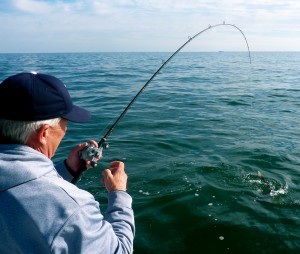 I recently discussed light tackle with some fishing buddies over a bottle of Tennessee’s finest. We all agreed that casting artificial lures on the Chesapeake Bay has the potential to catch as many big fish as any other method. I believe the chances for a trophy striper are better for those who know how to handle a light stick. Until a couple of years ago, most Mid-Atlantic fishermen would have laughed at a statement like that, but not anymore. Throughout 2010, light tackle casting held its own and often out-produced other methods of Chesapeake Bay fishing. It’s encouraging to walk into bait shops and tackle stores now and see Bass Kandy Delights, Bass Assassins, and top water plugs displayed prominently at the end of the aisles beside umbrella rigs and parachute lures. I’m very happy to promote light tackle fishing for one main reason – I don’t know a single light tackle fisherman who isn’t a conservationist. It is absolutely clear that anglers who cast artificial lures are hard-wired to protect the fish and to take care of the water they fish in. Read More!
I recently discussed light tackle with some fishing buddies over a bottle of Tennessee’s finest. We all agreed that casting artificial lures on the Chesapeake Bay has the potential to catch as many big fish as any other method. I believe the chances for a trophy striper are better for those who know how to handle a light stick. Until a couple of years ago, most Mid-Atlantic fishermen would have laughed at a statement like that, but not anymore. Throughout 2010, light tackle casting held its own and often out-produced other methods of Chesapeake Bay fishing. It’s encouraging to walk into bait shops and tackle stores now and see Bass Kandy Delights, Bass Assassins, and top water plugs displayed prominently at the end of the aisles beside umbrella rigs and parachute lures. I’m very happy to promote light tackle fishing for one main reason – I don’t know a single light tackle fisherman who isn’t a conservationist. It is absolutely clear that anglers who cast artificial lures are hard-wired to protect the fish and to take care of the water they fish in. Read More!
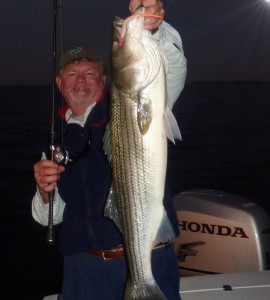 There’s a blue moon shining
There’s a blue moon shining
When I am reminded of all we’ve been through
Such a blue moon… shining
Does it ever shine down on you? -Nanci Griffith
I guess you could say my wife and I met on a blue moon. It was at least a rare occasion, one that I’ll never regret because, among other great things, it ultimately led me to the Chesapeake Bay. There’s some discussion about what makes a moon blue these days. The modern interpretation is that the blue moon is the second full moon in any given month, but there’s an older interpretation I like better. There are normally three full moons in each season whether spring, summer, fall, or winter, but sometimes, rarely, there is an extra full moon. Farmers and fishermen who plan their lives by the seasons refer to the usual full moon cycles in a three-name seasonal sequence – for example the early summer moon, mid summer moon, or late summer moon. The late moon is always the last of the season, so when that rarely occurring extra full moon comes along, it is left without a name. We call it the blue moon. That makes tonight, Sunday November 21st the blue moon of fall 2010. You can read more about it in this Space.com article. Since the phases of the moon drastically influence the tidal currents in the Chesapeake Bay, I pay very close attention. Read More!
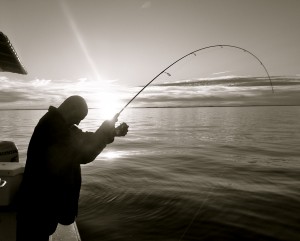 Whenever someone asks me how I feel about making striped bass a gamefish in Maryland, my answer is always the same – they already are. Light tackle anglers fish for striped bass almost the same as we would for black bass, trout, crappie, or walleye. Most of us use the same equipment. The only real difference I can see is that a few influential people in the mid-Atlantic find it profitable to commercially harvest stripers. I never heard of striped bass on a restaurant menu until I moved to Maryland. In fact, people in other parts of the country don’t consider them particularly good to eat. I cook them occasionally, but is any fish tasty enough to deserve all the controversy that surrounds striped bass? The biggest thing they have going for them is that they’re fun to catch and they’re pursued by more recreational anglers than any other species. In my book, that spells gamefish. Last week the Atlantic States Marine Fisheries Commission (ASMFC) voted down several amendments which would have increased the commercial harvest of striped bass. Maryland voted for no increase. That’s a positive sign from a state that traditionally harvests and sells more than its fair share, but it’s no reason to celebrate. Maintaining the status quo is just more bad news for the fish. Read More!
Whenever someone asks me how I feel about making striped bass a gamefish in Maryland, my answer is always the same – they already are. Light tackle anglers fish for striped bass almost the same as we would for black bass, trout, crappie, or walleye. Most of us use the same equipment. The only real difference I can see is that a few influential people in the mid-Atlantic find it profitable to commercially harvest stripers. I never heard of striped bass on a restaurant menu until I moved to Maryland. In fact, people in other parts of the country don’t consider them particularly good to eat. I cook them occasionally, but is any fish tasty enough to deserve all the controversy that surrounds striped bass? The biggest thing they have going for them is that they’re fun to catch and they’re pursued by more recreational anglers than any other species. In my book, that spells gamefish. Last week the Atlantic States Marine Fisheries Commission (ASMFC) voted down several amendments which would have increased the commercial harvest of striped bass. Maryland voted for no increase. That’s a positive sign from a state that traditionally harvests and sells more than its fair share, but it’s no reason to celebrate. Maintaining the status quo is just more bad news for the fish. Read More!
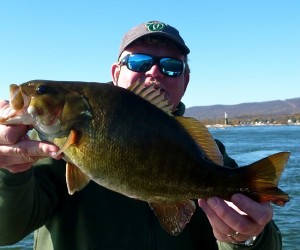 I had to pull a night shift at work this week, so I decided to reset my circadian clock with an early morning of smallmouth fishing on the Susquehanna river. Last July, I invited Bill Montgomery to join me for a Chesapeake Bay top-water striper trip near Poplar Island. Bill and I hit it off after finding we shared interests in both fishing and acoustic music. Bill returned my fishing favor by inviting me up to Pennsylvania to see one of his favorite bass spots. He fishes occasionally with his friend Dennis Mongold who is a smallmouth bass guide specializing in this section of the Susquehanna. I met them near Harrisburg where we loaded up in Dennis’s custom made aluminum jon-boat. The boat is specially outfitted for fishing this section of the rocky river. Dennis has his jet-drive outboard mounted on a hydraulic lift so he can adjust the draft for very shallow water. The bottom of the boat is coated with hard plastic so it can easily skim over the rocks. I’ve done a lot of river fishing, but this is the first time I’ve been on a boat running thirty miles per hour in four inches of water. I admit I was a little unnerved! Read More!
I had to pull a night shift at work this week, so I decided to reset my circadian clock with an early morning of smallmouth fishing on the Susquehanna river. Last July, I invited Bill Montgomery to join me for a Chesapeake Bay top-water striper trip near Poplar Island. Bill and I hit it off after finding we shared interests in both fishing and acoustic music. Bill returned my fishing favor by inviting me up to Pennsylvania to see one of his favorite bass spots. He fishes occasionally with his friend Dennis Mongold who is a smallmouth bass guide specializing in this section of the Susquehanna. I met them near Harrisburg where we loaded up in Dennis’s custom made aluminum jon-boat. The boat is specially outfitted for fishing this section of the rocky river. Dennis has his jet-drive outboard mounted on a hydraulic lift so he can adjust the draft for very shallow water. The bottom of the boat is coated with hard plastic so it can easily skim over the rocks. I’ve done a lot of river fishing, but this is the first time I’ve been on a boat running thirty miles per hour in four inches of water. I admit I was a little unnerved! Read More!
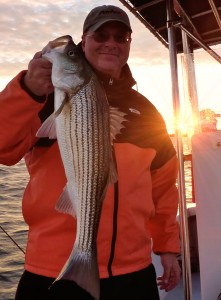 What has been will be again,
What has been will be again,
What has been done will be done again;
There is nothing new under the sun -Ecclesiastes 1:9
Since Candy Thomson published an article about my favorite jigging technique in today’s Baltimore Sun, I thought I might talk about it a little more. First, thanks to Candy for the nice write-up. She had originally planned to fish with us, but unfortunately broke a finger in a kayak accident a couple of days before. She decided to come along anyway and it was great having her, Joe, and Colin on Thunder Road for a fun evening of catching. I’m a big fan of Candy’s Outdoors Girl blog. I don’t always agree with her, but I never miss an entry. There’s no question that, despite the splint she’s wearing lately, she has her finger squarely on the pulse of outdoor issues in Maryland.
I’ll start this article by stating the obvious in that casting artificial lures for stripers using outfits made for freshwater black bass is nothing new – my father taught me to catch stripers using bass lures when I was very young. I had never heard of using heavy duty saltwater trolling gear for rockfish until I moved from Tennessee to Maryland. I was amazed and somewhat amused the first time I saw a twenty-five rod planer board trolling spread. Read More!
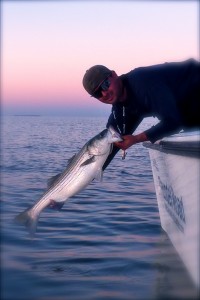 Since I’ve been reporting bigger migratory fish on my recent trips, I’ve been overwhelmed with questions about where the fish are. My apologies if I’ve yet to return a call or answer an email, but the absolute truth is – I don’t know. These big fish are moving around very quickly and they haven’t been at the same place twice. I think we sometimes put too much emphasis on locations, and not enough on patterns. Tell someone where to go to catch a fish and you may help them for a day, but teach them how to identify specific patterns of how fish behave, and you’ve helped them for a lifetime. Ask any good fisherman the secret to repeated success and he’ll tell you it’s the ability to distinguish specific feeding habits. I believe that you can drop a good fisherman into any body of water in the world and he’ll catch fish as long as you give him enough time to establish a prevailing pattern. It’s especially important on the Chesapeake where conditions change quickly and a rapid thirty degree temperature drop in October is not unusual. I think fishing conditions change faster and more often here than anywhere I’ve fished before. Fortunately, fish are usually creatures of habit and there are distinct patterns we can identify in the way they behave. Read More!
Since I’ve been reporting bigger migratory fish on my recent trips, I’ve been overwhelmed with questions about where the fish are. My apologies if I’ve yet to return a call or answer an email, but the absolute truth is – I don’t know. These big fish are moving around very quickly and they haven’t been at the same place twice. I think we sometimes put too much emphasis on locations, and not enough on patterns. Tell someone where to go to catch a fish and you may help them for a day, but teach them how to identify specific patterns of how fish behave, and you’ve helped them for a lifetime. Ask any good fisherman the secret to repeated success and he’ll tell you it’s the ability to distinguish specific feeding habits. I believe that you can drop a good fisherman into any body of water in the world and he’ll catch fish as long as you give him enough time to establish a prevailing pattern. It’s especially important on the Chesapeake where conditions change quickly and a rapid thirty degree temperature drop in October is not unusual. I think fishing conditions change faster and more often here than anywhere I’ve fished before. Fortunately, fish are usually creatures of habit and there are distinct patterns we can identify in the way they behave. Read More!


